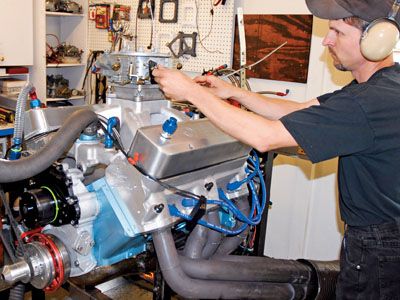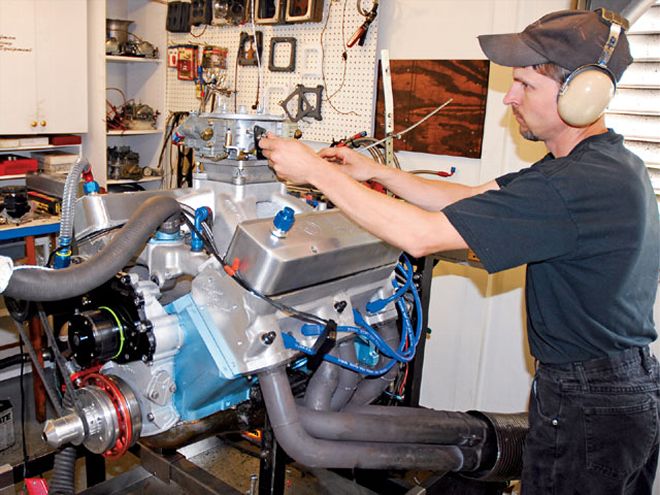

For an engine design that was ostensibly put out to pasture in 1979, the traditional Pontiac powerplant has enjoyed new life decades later, thanks to a few companies like Kauffman Racing Equipment (KRE) who have stepped up to service this dedicated market.
You've read about KRE's MR-1 block and High-Port Heads in HPP before, but this time we have a full buildup and an extended dyno thrash to illustrate their capabilities. Jeff and Mark Kauffman at KRE teamed up with Kevin Swaney of Tin Indian Performance (TIP) to build this 505ci, 851hp neck-snapper for racer and HPP shootout alumnus Mike Williams' '66 GTO.
While the exploits of KRE have been documented in these pages before, TIP is a name that may be new to you. TIP is a Pontiac parts supplier that works closely with KRE, recreating components that are increasingly scarce. Most of its parts are new and made with today's technology, such as gaskets made from Teflon-hardly a bone stock resto part from the '60s, but a great improvement for today. A few of these new items will be employed in Mike's engine.
MR-1 Block
Technically speaking, the MR-1 is actually a K&M Performance Parts MR-1 block. K&M Performance is owned by Steve Kauffman (Mark and Jeff's father) and racer Bill Mellott. All of the machining is done in-house at K&M Performance on its CNC milling center. Steve says it takes approximately 18 hours to fully machine a block from start to finish. The company currently offers the MR-1 blocks in cast iron, while the MR-1A is the cast-aluminum version. Both blocks come in PRO versions, which incorporate enhanced webbing designs and different main cap configurations. There's also a billet aluminum block for serious racers. Bill Mellott says that he knows demand for the billet block will most likely be low, yet K&M felt it was still a project worth pursuing to advance its own racing programs and the Pontiac aftermarket.
The MR-1 block will accept all stock Pontiac engine components and has a number of improvements over stock blocks: An upgraded design from the stock patterns, thicker decks, front four-bolt main caps and more. We'll illustrate these and many other features as the build progresses.
There is also an abundance of finished features incorporated into the block that make it almost a bolt-in. In fact, KRE tells us that after it's been bored and honed, all you have to do prior to assembly is to wash it. Now let's check out the heads.
High-Port Heads
The High-Port Heads were covered in-depth in the Feb. '08 issue's "Cylinder Head Symphony," so here are the basics. High Ports are the second aftermarket Pontiac cylinder heads from KRE, making their debut in 2005 with 56cc, CNC'd chambers. Like the KRE D-Port, the High-Port Heads utilize a fast-burn, heart-shaped chamber design. Flow is 330-cfm intake as-cast. They can be used on a minimum bore size of 4.150 inches and utilize 6.200-inch-long Ferrea 1200 series valves. Though they have 2.20 intake and 1.70 exhaust valves for our testing, they are upgradeable to 2.25 intakes and 1.75 exhaust if the customer desires.
KRE offers CNC porting options for its High-Port Heads as well. If that's not enough, a 400+ cfm rocker-shafted head is available for hardcore racers. Jeff and Mark tell us, "We have done a tremendous amount of R&D with this cylinder head, including hours of flow bench testing, dyno testing, and track testing. We are currently using MR-1 blocks and the High-Port Heads in our own (KRE & TIP) racing programs, which helps us refine our products to make them even better!"
Check out the photos and captions for buildup details.
"Stroker Kit Schooling" Addendum
As promised in "Stroker Kit Schooling," here are Jeff Kauffman's comments regarding stroker engine combos. "Long-stroke rotating assembly kits are popular with our customers. It's an easy way of increasing horsepower and hobbyists seem to like the 'bigger is better' theory. They can start with an ordinary 350 or 400ci block and end up with an engine with much larger displacement. Our basic kit starts at $1,695, which includes a cast Eagle crank, forged Eagle rods, SRP pistons, and various other high-quality components. It's also fully balanced. A forged-steel crankshaft from Ohio Crankshaft, and a few forged-steel and aluminum rods are among the available options."
When asked what negative aspects are associated with long-stroke rotating assembly kits, Kauffman says what he sees in street applications is fuel economy. "A larger engine will obviously have a greater appetite for fuel when compared to a smaller engine. When dealing with high output or race-type engines, however, we find that the added displacement from a stroker kit usually requires additional cylinder head airflow to make higher horsepower numbers, and that can sometimes require cylinder head port work or different castings all together." Rocky Rotella
Dyno Testing
Throwing a motor on a dyno and just reading off the numbers is like ordering a gourmet feast and quitting after the first course. You're just not reaping all the benefits or satisfaction. Dyno development is serious engine work and it's most often the place where the real secrets of a motor's potential are revealed.
The Kauffman brothers will tell you that it's the dyno and resulting tuning that separates the true engine builders and designers from those who merely assemble a collection of parts, then estimate the horsepower. Dynos effectively provide nearly instant results for each tuning change or parts swap. And we know you've heard it before, but true dyno work lets you compare apples to apples
In the case of the KRE/TIP 505, they had specific goals, yet an open-minded attitude toward experimentation with tuning. As usual, the first two passes on KRE's Superflow 901 Dyno were to establish a baseline.
Round 1
The 505ci engine was fitted with 330-cfm KRE High-Port Heads, a solid roller cam with 272/276-degree duration at 0.050 and 0.704/0.704 lift. It was installed 3 degrees advanced. The centerline and LSA specs were withheld by the builder. Valve lash was set to 0.028/0.028, timing was 32 degrees, No. 88/88 jets were used in a Holley 1050 Dominator, and 112-octane blue race fuel was run.
Round 2
The KRE team saw that while they may not have actually hit the wall on this combo, they wanted to try other options, so they swapped heads to ported 380-cfm KRE High-Ports. The intake ports were matched to the larger port openings on these heads and the cam was swapped to one with 280/284-degree duration with the same 0.704/0.704 lift. Jets in the bigger 1,250-cfm Dominator were No. 100/100, valve lash was 0.025/0.025, and timing was set to 30 degrees to begin the second round of pulls. Once again 112-octane blue race fuel was used.
"How much power can I expect to see with alcohol?" is a common question by KRE customers. To find out, the boys decided to try some alcohol on the 505 for the 10th pull. They swapped out the Holley carb for a 4.00-inch Ron's Flying Toilet injection system and the results were an increase of 5 hp at a slightly lower 6,700 rpm and torque improved by 17 lb-ft. KRE made more pulls on alky, but this was the best one.
The average power on gas from 5,100 to 7,000 rpm was 783 hp/693 tq.
Benefits from running alcohol include consistency and lower temperature. KRE normally sees more increases in peak torque than peak horsepower with alcohol, and improvements in overall average power as well, as evidenced here. Since average power is more important than peak power, alcohol, in these tests, has proven its worth.
High Performance {{{Pontiac}}} Engine Buildup WorksheetConclusion
If you've ever had any doubt about the cost and value of dyno development, go back and look over those numbers and tuning changes. The first gas pull netted 727 horses and the last, 851. It was certainly worth KRE's, TIP's and Mike's time and energy. This story also served to exploit the power-making capabilities of the MR-1 block and High-Port Head combo for racing. Mike is still grinning about his new 505.